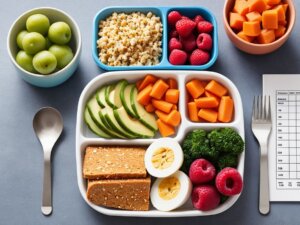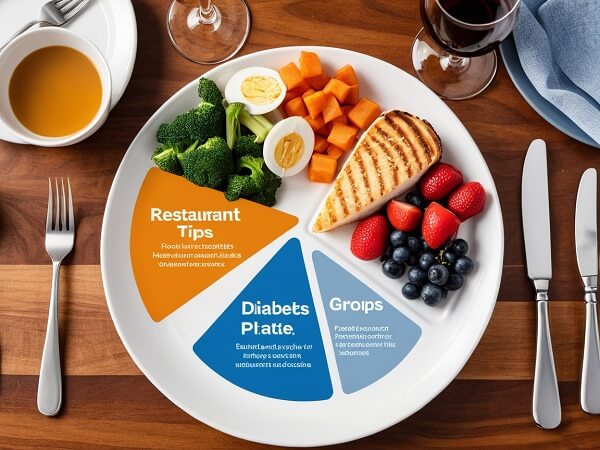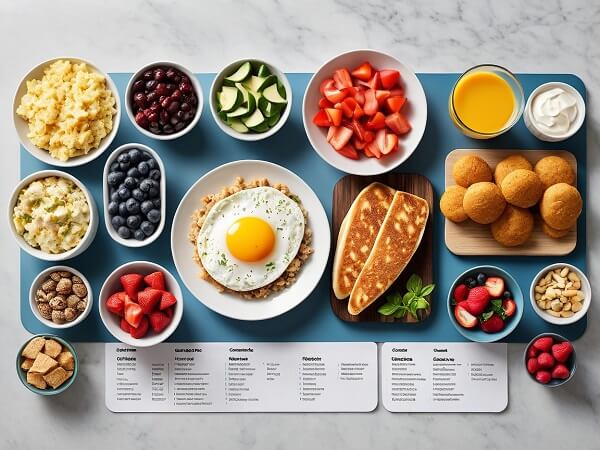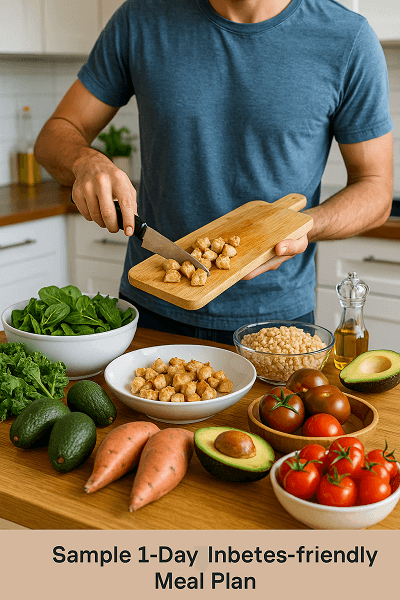Introduction: Understanding the Importance of Nutrition in Type 2 Diabetes
What you eat with type 2 diabetes directly impacts how well you manage your blood sugar levels and overall health. In fact, choosing the best foods for type 2 diabetes management can help you stabilize glucose, improve energy, and prevent complications. Whether you’re newly diagnosed or simply want to improve your habits, this guide breaks down the top food choices, eating patterns, and essential tips for building a balanced, diabetes-friendly diet. By focusing on whole, nutrient-rich foods, you can support your metabolism, reduce insulin resistance, and feel more energetic throughout the day.
⚠️ Disclaimer: This article is for informational purposes only. It is not intended to substitute professional medical advice, diagnosis, or treatment. Always consult with your healthcare provider or a registered dietitian before making any changes to your diet or lifestyle, especially if you have type 2 diabetes.
Section 1: Key Nutrition Goals for Managing Type 2 Diabetes
Managing type 2 diabetes is more than just cutting sugar—it’s about understanding your body’s nutritional needs and making consistent, smart choices.
Here are the primary nutrition goals:
-
✅ Control Blood Glucose Levels: Choose foods that have a low glycemic index to avoid sharp spikes in blood sugar.
-
✅ Support Heart Health: Focus on healthy fats and fiber-rich foods to lower cholesterol and reduce cardiovascular risk.
-
✅ Manage Weight: Balanced meals with lean protein, fiber, and healthy carbs help maintain a healthy weight.
-
✅ Prevent Complications: Antioxidant-rich foods reduce inflammation and protect against damage to blood vessels and nerves.
Tip: Consistency in meal timing and portion control plays a big role in keeping glucose levels stable.
Section 2: The Best Foods to Eat with Type 2 Diabetes
Knowing what to eat with type 2 diabetes is essential for maintaining stable blood sugar levels and promoting overall well-being. Let’s explore the most diabetes-friendly food groups that should make up the foundation of your diet.
1. Non-Starchy Vegetables (Low in Carbs, High in Fiber)
These vegetables are low in calories and carbohydrates, making them perfect for blood sugar control.
-
Spinach
-
Kale
-
Broccoli
-
Cauliflower
-
Bell peppers
-
Zucchini
Benefits: Rich in fiber, antioxidants, and essential vitamins. These help reduce inflammation and slow the absorption of sugar into the bloodstream.
2. Whole Grains (High-Fiber Carbohydrates)
Unlike refined grains, whole grains are absorbed slowly and have a lower glycemic index.
-
Quinoa
-
Brown rice
-
Oats
-
Buckwheat
-
Barley
Tip: Always read labels. Look for “100% whole grain” or “whole wheat” as the first ingredient.
✅ Why it matters: Whole grains help reduce insulin resistance and support digestive health.
3. Lean Proteins (Build Muscle, Keep You Full)
Proteins don’t raise blood sugar and help maintain muscle mass, especially when losing weight.
-
Chicken breast (skinless)
-
Turkey
-
Eggs
-
Tofu
-
Tempeh
-
Fatty fish like salmon or sardines (rich in omega-3s)
Bonus: Omega-3-rich fish support heart health, a major concern for people with type 2 diabetes.
4. Legumes and Beans (Plant-Based Powerhouses)
Beans are loaded with fiber and protein, making them a slow-digesting carb choice.
-
Lentils
-
Chickpeas
-
Black beans
-
Kidney beans
Fun Fact: Just 1/2 cup of cooked beans provides around 8 grams of protein and 7 grams of fiber!
5. Healthy Fats (Support Hormones and Satiety)
Fats don’t raise blood sugar, but the type of fat matters.
-
Avocados
-
Nuts (almonds, walnuts)
-
Seeds (chia, flaxseed)
-
Olive oil
Key Benefit: Healthy fats help you feel full longer, which can reduce the temptation to snack on refined carbs.
6. Low-Glycemic Fruits (In Moderation)
Fruits contain natural sugars, but many are safe to eat in moderation.
-
Berries (blueberries, strawberries)
-
Apples
-
Pears
-
Oranges (in whole form)
Note: Always pair fruit with protein or fat (like almonds or yogurt) to prevent sugar spikes.
Section 3: Foods to Limit or Avoid with Type 2 Diabetes
While it’s crucial to focus on the best foods for type 2 diabetes management, it’s equally important to understand which foods can disrupt your blood sugar levels or worsen insulin resistance. Avoiding certain items is just as vital as making smart dietary choices. Here’s a breakdown of foods to watch out for:
1. Sugary Beverages (Liquid Sugar Bombs)
-
Soda
-
Sweetened teas
-
Energy drinks
-
Fruit juices (even 100% juice in excess)
Why to avoid:These drinks are rapidly absorbed, causing immediate blood sugar spikes. Plus, they’re packed with empty calories.
Tip: Choose water, unsweetened herbal teas, or sparkling water with lemon instead.
2. Refined Carbohydrates (Stripped of Fiber)
-
White bread
-
White rice
-
Pastries
-
Breakfast cereals (most)
-
Pasta made from white flour
Effect: These foods raise blood sugar quickly and offer little nutritional value. They also increase cravings, leading to overeating.
3. Processed Snacks and Baked Goods
-
Chips
-
Crackers
-
Cookies
-
Cakes
-
Packaged muffins
Problem: These are typically high in sugar, refined flour, and unhealthy fats—all of which can worsen insulin resistance and promote weight gain.
4. Trans Fats and Hydrogenated Oils
-
Fried fast food
-
Margarine
-
Shortening
-
Packaged snacks with “partially hydrogenated oils”
⚠️ Why it matters:Trans fats raise LDL (bad) cholesterol and lower HDL (good) cholesterol, increasing your risk of heart disease—a major concern for people with diabetes.
5. High-Sodium Foods
-
Canned soups
-
Processed meats (like sausages or hot dogs)
-
Frozen dinners
-
Packaged sauces and seasonings
Impact: Too much sodium can lead to high blood pressure, which compounds diabetes-related cardiovascular risks.
✅ Alternative: Choose low-sodium or no-salt-added products. Use herbs and spices for flavor.
6. Full-Fat Dairy and Cream-Based Products
-
Whole milk
-
Heavy cream
-
Ice cream
-
Cheese spreads
Moderation is key: If you choose dairy, go for unsweetened, low-fat versions like Greek yogurt or part-skim cheese.
7. Alcohol (With Caution)
-
Beer
-
Sweet wines
-
Sugary cocktails
Warning: Alcohol can cause both high and low blood sugar, especially when taken without food or in excess. Always consult your doctor if you drink alcohol.
Section 4: Sample Daily Meal Plan for Type 2 Diabetes
(Balanced and Practical Eating for Beginners)
Designing a daily meal plan when you’re newly diagnosed with type 2 diabetes might feel overwhelming. But with a few strategic choices and a focus on the best foods for type 2 diabetes management, you can create a satisfying, blood-sugar-friendly routine. Here’s a beginner’s sample that includes what to eat with type 2 diabetes for steady energy and better glycemic control.
Breakfast: Fuel for a Stable Morning
-
1 slice of whole grain toast
-
2 scrambled eggs (cooked in olive oil or avocado oil)
-
½ avocado, sliced
-
1 cup of unsweetened green tea or black coffee
-
Optional: A handful of blueberries or a small apple
💡 Why it works: This meal is rich in protein, fiber, and healthy fats—key for controlling morning blood sugar spikes.
Lunch: Balanced and Satisfying
-
Grilled chicken breast or tofu (3-4 oz)
-
Large salad with leafy greens, cherry tomatoes, cucumbers, bell peppers
-
Dressing: Olive oil, lemon juice, and a pinch of salt
-
½ cup quinoa or brown rice
Tip: Include non-starchy vegetables in every lunch. They’re low in carbs and high in fiber.
📌 Optional snack (2–3 hours later):A small handful of almonds or celery sticks with hummus.
Dinner: Light and Nutrient-Rich
-
Baked salmon or mackerel
-
Steamed broccoli or asparagus
-
Small sweet potato (roasted or boiled)
-
Side salad with vinaigrette
Why it works: Rich in omega-3s and antioxidants, this meal supports heart health and minimizes late-night sugar crashes.
Evening Snack (Optional but Strategic)
-
Greek yogurt (unsweetened)
-
Cinnamon sprinkle or a few chopped walnuts
Benefit:Helps reduce nighttime hunger and supports stable fasting blood sugar levels.
✅ Pro tip: Keep your evening snack low in sugar and carbs to avoid morning hyperglycemia.
📅 Customize It!
You can swap proteins (chicken, turkey, legumes), vary vegetables (spinach, green beans, zucchini), or rotate healthy carbs (lentils, oats, barley) to keep meals interesting and enjoyable.
Section 7: Sample 1-Day Meal Plan for Type 2 Diabetes
(Balanced, Simple, and Delicious)
Planning meals with type 2 diabetes doesn’t have to be complicated. Below is a beginner-friendly sample meal plan that prioritizes blood sugar stability, satiety, and enjoyment.
📝 Note: Portion sizes and carbohydrate counts can vary based on your personal goals, medications, and nutritional needs. Always consult with a registered dietitian or healthcare provider for tailored advice.
Breakfast: Veggie Omelet + Whole Grain Toast
-
2 eggs scrambled with spinach, mushrooms, and bell peppers
-
1 slice of 100% whole grain toast with avocado spread
-
1 cup of black coffee or herbal tea
-
Optional: Small apple (if blood sugar allows)
✅ Why it works: High in protein and fiber, low in refined carbs—this breakfast fuels your morning and keeps you full longer.
Lunch: Grilled Chicken Salad Bowl
-
Grilled chicken breast (100–120g)
-
Mixed leafy greens (spinach, arugula, romaine)
-
Cucumber, cherry tomatoes, shredded carrots
-
2 tablespoons of olive oil vinaigrette
-
1 small whole wheat pita or ½ cup of cooked quinoa
✅ Why it works: This lunch provides lean protein, healthy fats, and fiber-rich veggies—key to preventing glucose spikes.
Snack: Greek Yogurt with Berries
-
½ cup plain, unsweetened Greek yogurt
-
A handful of fresh or frozen berries (e.g., blueberries or raspberries)
-
Sprinkle of chia seeds or cinnamon
✅ Why it works: A balanced snack with probiotics, antioxidants, and fiber to curb cravings and maintain steady blood sugar.
Dinner: Baked Salmon + Roasted Veggies + Brown Rice
-
Baked or grilled salmon filet (rich in omega-3s)
-
Roasted Brussels sprouts, zucchini, and carrots
-
½ cup of cooked brown rice
-
Water with lemon or herbal iced tea
✅ Why it works: A wholesome dinner that supports heart health, satisfies hunger, and promotes glucose stability overnight.
Optional Evening Snack (if needed):
-
10–12 almonds or walnuts
-
Unsweetened almond milk
-
A few cucumber slices
✅ Why it works: Light, low-carb, and rich in healthy fats—perfect if you need a small bite before bed.

Section 8: Tips for Eating Out with Type 2 Diabetes
(Smart Strategies for Restaurants and Social Events)
Managing type 2 diabetes doesn’t mean you have to skip dinners out with friends or avoid your favorite restaurants. With a few smart strategies, you can enjoy delicious food while staying in control of your blood sugar.
1. Review the Menu Before You Go
Many restaurants now post their menus online. Take a moment to scan for diabetes-friendly options that align with the best foods for type 2 diabetes management—like grilled proteins, whole grains, and vegetable-based dishes. Planning ahead removes pressure and helps you make more mindful decisions.
2. Choose Balanced Plates
Use the “diabetes plate method” as a guide:
-
½ of your plate: non-starchy vegetables (e.g., broccoli, spinach, salad greens)
-
¼ of your plate: lean protein (e.g., grilled chicken, tofu, fish)
-
¼ of your plate: healthy carbs (e.g., sweet potato, brown rice, quinoa)
💡 Tip: Ask to substitute fries or white rice with steamed veggies or salad.
3. Skip the Free Bread or Chips
It’s tempting, but these refined carbs can spike your blood sugar before the main course arrives. Ask your server not to bring them or simply pass.
4. Watch the Drinks
Many restaurant beverages are loaded with sugar. Instead, opt for:
-
Water with lemon
-
Sparkling water
-
Unsweetened iced tea
-
Black coffee (if not too late in the day)
🚫 Avoid: Regular sodas, sweetened cocktails, creamy coffee drinks.
5. Share or Skip Dessert
If you’re craving something sweet, consider sharing with the table or asking for a fruit-based dessert. Alternatively, enjoy a decaf coffee or herbal tea to signal the end of your meal.
6. Don’t Be Afraid to Ask
Requesting sauce on the side, smaller portions, or ingredient swaps is absolutely okay. Most restaurants are happy to accommodate dietary needs.

Section 9: Worst Foods to Avoid with Type 2 Diabetes
(What to Steer Clear of to Keep Blood Sugar in Check)
Just as it’s important to focus on the best foods for type 2 diabetes management, it’s equally crucial to understand what foods can worsen your condition. Some choices may seem innocent but can cause blood sugar spikes, increase insulin resistance, or lead to complications in the long run.
🚫 1. Sugary Beverages
Regular sodas, energy drinks, sweetened teas, and fruit juices can contain over 30 grams of sugar per serving. These drinks digest quickly and cause blood sugar to rise rapidly.
Better Alternatives: Water, sparkling water, herbal teas, or infused water with fresh fruit slices.
2. Refined Carbohydrates
White bread, pastries, crackers, and many packaged snacks are made with refined flour and little fiber. These high-glycemic carbs can quickly elevate glucose levels.
Better Alternatives: Whole grain bread, oat-based snacks, almond flour crackers.
3. Fried and Fast Foods
Foods like French fries, fried chicken, or fast-food burgers are high in trans fats, carbs, and calories. They may also increase inflammation and cholesterol levels.
Better Alternatives: Baked sweet potato, grilled proteins, or home-prepared meals with healthy oils like olive or avocado oil.
4. Sweets and Desserts
Cookies, cakes, ice cream, and candy are high in added sugars and unhealthy fats. They offer little nutritional value and can cause glucose spikes and weight gain.
Better Alternatives: Dark chocolate (85%+ cocoa), chia pudding, Greek yogurt with berries.
5. Processed Meats
Sausages, bacon, and deli meats are often high in sodium and saturated fats, increasing heart disease risk—a major concern for diabetics.
Better Alternatives: Grilled chicken, fish, eggs, tofu, or legumes.
6. “Low-Fat” Packaged Foods
Many low-fat or diet-labeled foods are packed with added sugars and artificial ingredients to make up for flavor. These can still impact blood sugar negatively.
Better Alternatives: Stick to whole, unprocessed foods and read labels carefully.
Remember: Occasional indulgence isn’t the problem—it’s consistency. The goal is to avoid turning these foods into dietary staples.

Section 10: Sample 1-Day Diabetes-Friendly Meal Plan
(Practical Tips for Crafting Your Meals)
Creating balanced, diabetes-friendly meals can seem overwhelming at first, but it’s easier than it sounds with a little planning. The key is to include the best foods for type 2 diabetes management—such as fiber-rich vegetables, lean proteins, healthy fats, and low-glycemic carbs—to help manage blood sugar levels throughout the day. Here’s a sample 1-day meal plan designed to give you ideas for diabetes-friendly meals:
Breakfast: Avocado Toast with Eggs
-
Ingredients:
-
1 slice of whole-grain bread
-
½ avocado, mashed
-
2 boiled or scrambled eggs
-
A sprinkle of chili flakes (optional)
-
A drizzle of olive oil
-
-
Why It’s Great:
-
Whole grain bread provides fiber, which helps stabilize blood sugar.
-
Eggs are a great source of protein and help keep you full longer.
-
Avocado offers healthy fats that support heart health and improve insulin sensitivity.
-
Lunch: Grilled Chicken Salad with Olive Oil Dressing
-
Ingredients:
-
4 oz grilled chicken breast
-
Mixed greens (spinach, arugula, lettuce)
-
1 tomato, sliced
-
½ cucumber, sliced
-
2 tbsp olive oil (for dressing)
-
1 tbsp apple cider vinegar
-
Salt and pepper to taste
-
-
Why It’s Great:
-
Lean protein from chicken supports muscle maintenance and helps balance blood sugar levels.
-
Olive oil provides heart-healthy fats, which are essential for diabetes management.
-
Leafy greens and vegetables are low in calories and carbohydrates, perfect for regulating blood sugar.
-
Dinner: Baked Salmon with Steamed Veggies and Quinoa
-
Ingredients:
-
4 oz salmon fillet
-
½ cup cooked quinoa
-
Steamed broccoli, carrots, and zucchini
-
A squeeze of lemon juice
-
Fresh herbs for garnish
-
-
Why It’s Great:
-
Salmon is rich in omega-3 fatty acids, which help reduce inflammation and improve heart health.
-
Quinoa is a whole grain, high in protein and fiber, making it a great carb source for diabetics.
-
Steamed veggies are nutrient-dense and provide fiber without causing blood sugar spikes.
-
Snack: Greek Yogurt with Berries
-
Ingredients:
-
½ cup plain Greek yogurt
-
¼ cup mixed berries (blueberries, strawberries, raspberries)
-
1 tsp chia seeds (optional)
-
-
Why It’s Great:
-
Greek yogurt is high in protein and probiotics, which support gut health and digestion.
-
Berries are a low-glycemic fruit that won’t spike blood sugar but will satisfy sweet cravings.
-
Chia seeds add fiber and omega-3s, further helping to manage blood sugar.
-
Drink: Herbal Tea or Water with Lemon
-
Why It’s Great:
-
Staying hydrated is key for managing blood sugar and overall health.
-
Herbal teas, such as chamomile or peppermint, are soothing and contain no added sugars.
-
Pro Tip: You can easily swap ingredients to suit your taste preferences or dietary restrictions. For example, if you prefer a plant-based option, you can replace the chicken with tofu and the salmon with a plant-based omega-3 source like flaxseeds or chia seeds.

Section 11: Conclusion and Final Tips for Managing Type 2 Diabetes through Nutrition
Managing type 2 diabetes doesn’t have to be overwhelming. With the right knowledge and a balanced approach to nutrition—especially by focusing on the best foods for type 2 diabetes management—you can take control of your health and make informed decisions that support your lifestyle. Eating the right foods at the right times can help you regulate blood sugar, improve insulin sensitivity, and prevent complications that are common in diabetes, such as heart disease and neuropathy.
For more comprehensive information on how nutrition affects diabetes management, check out the American Diabetes Association’s guide on nutrition.
Here’s a quick recap of the essential principles for managing Type 2 diabetes through nutrition:
1. Focus on Low-Glycemic Foods
-
Opt for foods that have a low glycemic index (GI) to help prevent blood sugar spikes. These foods release glucose slowly, allowing your body to manage blood sugar levels more effectively.
-
Examples: Whole grains, leafy greens, beans, and non-starchy vegetables.
2. Embrace Healthy Fats
-
Healthy fats, like those from avocados, nuts, seeds, and olive oil, can help improve insulin sensitivity and promote heart health. Avoid trans fats and limit saturated fats, as these can raise cholesterol levels and increase the risk of heart disease.
3. Incorporate Lean Proteins
-
Include lean proteins in your diet to support muscle repair and overall health. Foods like chicken, turkey, fish, tofu, and beans are great options. Protein helps to stabilize blood sugar levels and keeps you feeling full longer.
4. Eat Fiber-Rich Foods
-
Fiber plays a key role in stabilizing blood sugar by slowing the absorption of sugar into the bloodstream. Aim to eat a variety of fiber-rich foods such as vegetables, fruits (in moderation), legumes, and whole grains.
5. Stay Hydrated
-
Proper hydration is essential for overall health and managing diabetes. Water is the best choice, but you can also enjoy herbal teas or water infused with fresh lemon for added flavor. Avoid sugary drinks and sodas, as these can quickly spike blood sugar.
6. Portion Control
-
Pay attention to portion sizes to avoid overeating and to help with blood sugar control. A balanced plate should include a variety of food groups, with half of your plate filled with non-starchy vegetables, a quarter with lean protein, and a quarter with healthy carbs.
7. Plan Your Meals
-
Meal planning is one of the most effective ways to ensure that you’re making nutritious and diabetes-friendly food choices. Preparing meals ahead of time can help prevent last-minute decisions that may lead to unhealthy eating.
Final Thoughts: Empower Yourself Through Nutrition
By understanding what to eat with Type 2 diabetes and how food impacts your body, you’re already taking a step in the right direction. It’s not just about following a list of “approved” foods—it’s about creating a sustainable, balanced approach to eating that works for you.
Remember, you’re in control of your health. With time, consistency, and the right resources, you’ll find that managing Type 2 diabetes through nutrition becomes second nature. Keep experimenting with new foods, enjoy meals with loved ones, and embrace the journey to better health!
Now that you have a solid understanding of the best foods for type 2 diabetes management, feel free to explore our other resources to deepen your knowledge. We’ve covered the basics of nutrition for people with type 2 diabetes, but for more information on healthy foods, don’t forget to check out our previous article on the top 10 superfoods for people with diabetes here
